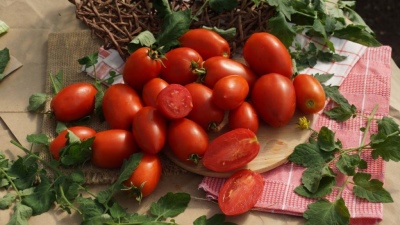
- Authors: Fotev Yu. V., Kotelnikova M. A., Kondakov S. N. (originators: Fotev Yu. V., Kondakov S. N., Agrofirma "Altai Seeds" LLC)
- Year of approval: 2010
- Category: grade
- Growth type: determinant
- Appointment: fresh consumption, for pickling and preserving
- Ripening period: mid-early
- Ripening time, days: 105-115
- Growing conditions: for open ground, for film greenhouses
- Transportability: excellent
- Bush size: undersized
This crop has been grown in vegetable gardens for quite some time. And a thorough acquaintance with it will allow many farmers to get quite large yields. There is little to do - to investigate objective information.
Breeding history
Combat is one of the products of the well-known agricultural firm "Altai Seeds". The development was supervised by breeders Kotelnikova, Fotev and Kondakov. The latter two also became the originators of this plant. The main breeding preparation was carried out in the 2000s. In 2010, Kombat opened the way to consumer gardens by entering it into the State Register.
Description of the variety
The bushes of this plant are undersized (they rise to a maximum of 0.9-1 m). The tomatoes themselves develop very compactly. Moderately large green foliage, typical for most other varieties, is formed on them. The formation of a trunk is usually noted.
The main qualities of the fruit
Initially, the young Kombat berries are light green in color. As vegetative development progresses, they will turn into an attractive red. The usual weight of tomatoes is 0.095 kg. They are typically cylindrical in shape. A crop develops from simple inflorescences.
Taste characteristics
For Kombat, pleasant sweetness is typical. This sensation is all the more impressive since the fruit pulp is also fleshy. The smooth skin that forms on the surface does not negatively affect the perception of the crop. The bulk of each tomato is dense.
Ripening and fruiting
The official description mentions that Kombat is a mid-early variety. It takes 105-115 days for its fruits to develop after the emergence of green shoots. It will be possible to harvest the berries in July and August. Only occasionally does the weather forcefully adjust such a schedule.
Yield
The plant is considered to be a high-yielding type. The average collection is 6.4 kg per 1 sq. m. Of course, sometimes the total turns out to be a little more, and sometimes - a little less. The final result depends on the diligence of the farmers as much as on the actual weather and the quality of the site.
The timing of planting seedlings and planting in the ground
It is necessary to spread seeds on nutrient soil or soil mixture laid out in containers in March. Whether to use a self-prepared or purchased substrate is up to the gardeners themselves. It must be emphasized that it is hardly reasonable to plant seedlings in the ground before 60-65 days. A specific reference point will be a fairly high strength of plants and an excellent quality of their development.

Growing tomato seedlings is an extremely important process, because it largely depends on whether the gardener will be able to harvest at all. All aspects must be taken into account, from seedbed preparation to planting in the ground.
Landing scheme
In this regard, the Combat does not demonstrate anything particularly original. It should be planted according to the rule of 400x500 mm. It is worth noting that this information is not provided by official suppliers, but by third-party sources, so some gardeners may take a risk.

Growing and care
Tomato Kombat quite staunchly resists the defeat of Alternaria and Septoria. But protection from these diseases, as well as from other ailments and insects, is still important. Most often, special drugs or improvised means are used for preventive purposes, working proactively. Culture will definitely have to be pinned. Before planting, the holes are abundantly moistened and the earth is allowed to settle for 30-60 minutes.
The first watering is done immediately after planting the tomato. Further, this cannot be done for about 10-12 days, so that the plant develops its roots to the maximum. An exception is made only for periods of abnormally intense heat. Passionking is carried out in moderation. For the rest, the culture does not impose any special requirements.




A plant needs different micronutrients at each stage of growth. All fertilizers can be divided into two groups: mineral and organic. Folk remedies are often used: iodine, yeast, bird droppings, eggshells.
It is important to observe the rate and period of feeding. This also applies to folk remedies and organic fertilizers.


Growing regions
This variety is suitable for a wide variety of Russian areas. With equal success, it can be cultivated on their plots:
- near Moscow;
- far eastern;
- Siberian;
- Ural;
- Volga;
- North Caucasian;
- central black earth;
- farmers living in the center and in the north of the European part of the Russian Federation.

























































































